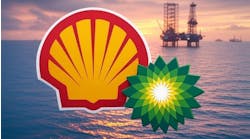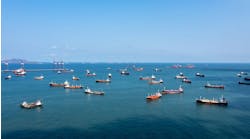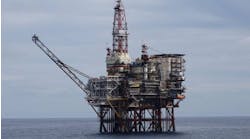West Africa remains a critical region for the international oil community.
With the political climate in the Middle East and parts of Latin Ame-rica making operations difficult in many areas, international oil companies (IOCs) seeking to maintain long-term oil and gas supply are developing diverse and viable portfolios. Increasingly, the need to diversify leads to Africa.
There is competition for African acreage, particularly from Asian national oil companies seeking to fuel their burgeoning economies. The China-Africa summit held in Beijing in November 2006 was as much about pragmatic trade links for securing oil and mineral supplies as it was about political gestures.
For IOCs, it is also the size of a potential discovery that commands their interest. In Angola, Congo, and Nigeria, the possibility of material discoveries in excess of 100 MMboe (either in a single discovery or in a cluster) remains favorable and continues to make the region an investment magnet.
IHS maintains a global index based on a weighted set of criteria from which to determine the attractiveness of a region to foreign investors. The criteria include E&P activity, fiscal regime, and political risk. According to analysis based on the weighted criteria, countries in the Gulf of Guinea are well up on the global scale.
Frontier exploration
Inland African basins are attracting increasing attention for frontier exploration. In the East African rift system in Uganda, Hardman and partners successfully drilled Waraga 1 and Mputa 1 on the shores of Lake Albert. Further appraisal drilling programs are awaited in 2007. Recoverable volumes have most recently been cited at 30 MMbbl, but further prospects under Lake Albert scheduled to be tested in 2007 could push this number up. In adjacent block 3A, Heritage Oil successfully drilled Kingfisher 1, which flowed 4,120 b/d of 30° API oil on test.
These successes have driven companies to take up similar acreage in the western side of the lake in the Democratic Republic of Congo (DRC), in Lake Tanganyika, and in neighboring Tanzania and Kenya.
In Nigeria, there has been a political push for inland exploration for many years, but this pressure has not contributed to the overall geological attractiveness of the Chad basin, where more than 25 dry holes have been drilled. Nevertheless, some blocks will again be made available in the next bid round (now scheduled for 1Q 2007).
Offshore, the overheated rig rates are affecting risky frontier projects. It is thought that BHP-Billiton’s planned deepwater exploration well in the Orange basin off South Africa (Cabernet prospect) has been jeopardized not only by contractual difficulties, but also by the fact that fifth generation rig rates have increased from $250,000 to in excess of $450,000 per day.
Mobilization-demobilization to this remote part of West Africa adds considerably to the exploration well budget, which now exceeds $70 million for a single well with a 15-20% chance of success.
Another such single-well project is Canadian Natural Resources’ Paddavissie prospect in the Southern Outeniqua basin off the southern coast of South Africa. Paddavissie may be drilled in 2007 or 2008.
CNR is unusual in that it has kept a 100% working interest in this project, but the Canadian independent has mitigated the risk though use of controlled source electromagnetic (EM) techniques to identify, categorize, and classify direct hydrocarbon indicators (DHIs). The Paddavissie fan is huge, with well defined DHIs. The Petroleum Agency of South Africa has cited unrisked estimates of oil in place at 2 Bbbl.
Exploration in more mature basins
The Kudu gas project offshore Namibia could well be sanctioned in 2007 (disagreements between the downstream partners have held up the final investment decision). Meanwhile, upstream operator Tullow is also looking at a “big-bang” increment to gas reserves through drilling two new appraisal wells in 1Q 2007. If these wells are successful, reserves could be increased to the magic export threshold of 4-5 tcf.
Offshore Angola in 2006, residual exploration acreage in blocks 15, 17, and 18, was re-awarded after competitive bidding. ENI and partners won block 15 against a $902 million bonus, with a commitment for five exploration wells, the first of which should be drilled in 2007.
In block 17, Total has been re-awarded operatorship of its old acreage, but negotiations are continueing over the bonus and the conditions. Total may forego the ex-Fina onshore fields (providing an opportunity for another player).
With substantial production infrastructure in place (Girassol, Dalia, and others planned), Total should be able to tie back any modest size new discoveries (50 MMbbl) found in block 17/06.
Chevron is another operator looking to develop small oil pools. For Lianzi (Joint Angola-Congo Zone) and Gabela (block 14), low-cost solutions are being evaluated, involving tie-back, either to its own, or - in a novel concept - to a nearby operator’s facilities.
Sonangol is scheduled to offer new exploration acreage in 2007, including the North West ultra deep outboard of blocks 31. This should attract the major IOCs. Offshore acreage in the Kwanza/Benguela basins also is to be included.
Offshore Congo, IOCs are continuing to explore deepwater. The area is very prospective because the geology of the Congo fan is the same as in Angola. Murphy Oil, Total, and ENI (with ExxonMobil) are all looking at deepwater turbidite plays. A number of exploration drilling successes (Azurite 1, Andromede 1, Pegase Nord 1, and Aurige 1) have been recorded.
Congo remains a very prospective country, both onshore and offshore, and new players (notably Sinopec) are queuing up for contracts.
Not surprisingly, the region offshore Nigeria, including the Nigeria-Sao Tome Joint Development Zone (JDZ) will also be active in the coming year.
Recently, deepwater Nigeria has not been as successful as Angola. Despite this and the vagaries of the Nigerian bidding system, new operators keep coming in.
Following awards in 2005, BG, Korea National Oil Co., and ONGC of India will be drilling first obligation wells in early 2008.
Devon Energy will drill its third and final obligation well in OPL 256, following two failures. The company also plans to drill the first well in OPL 242.
Shell plans to drill appraisal wells to the Etan and Zabazaba discoveries in OPL 245, while Petrobras is set to drill the first well in OPL 315, and Chevron the first well in undrilled OPL 247.
ExxonMobil also will be working in the area, carrying out appraisal of the Uge 1 discovery in OPL 214, which is the most recent, sizeable deepwater discovery in the Niger Delta with 100 m (328 ft) net oil pay. ENI will drill a further appraisal, Oyo 3, in the Oyo field (OML 120). And Chevron and partners will appraise the Obo 1 discovery in the JDZ with one or two more wells.
Despite press enthusiasm, the Obo 1 discovery was disappointing (IHS estimates 75-100 MMbbl of oil), rendering it as yet sub-commercial.
Offshore Equatorial Guinea, Noble Energy has hired theSonga Saturn drillship with a 1,006-m (3,300-ft) depth rating for three wells plus two options and will drill three exploration wells in block I and block O, early in 2007.
The drillship could also be deployed in Cameroon, where Noble has additional exploration interests.
Despite a lack of success in deepwater Gabon, it remains an attractive E&P destination primarily because of its benign fiscal terms and stable political climate. Exploration efforts recently have been concentrated in the South Gabon basin - targets are the presalt Gamba play.
Development activity
The coastal basins and offshore are seeing considerable developmental activity throughout West Africa.
Massive investment is pouring in offshore Angola. Investment dollars are pumping up the country as one of the largest investment foci in Africa. In investment circles, Angola has been dubbed “the new Kuwait” (appropriate, perhaps, if Angola goes ahead to become an OPEC member).
Engineering, fabrication, and supply sectors are well developed in Angola, but South Africa is competing to supply this enormous market, with South African yards providing maintenance for passing rigs.
New projects include the planned field developments in deepwater blocks 31 and 32. Following the incredible success that operators BP (block 31) and Total (block 32) have had with discovering oil pools under or adjacent to salt structures, the essential question is how many production centers are to be established in these blocks. There will be at least two, but there could be even more multi-billion dollar projects per block, each to produce around 150,000 b/d of oil.
Angolan independents are emerging in 2007. Among them are ACR, Falcon Oil, Prodoil, Grupo Gema, and Force, though their primary interests at present are onshore.
Total is progressing the Moho-Bilondo pro- ject offshore Congo. The first phase concentrates on Tertiary reservoirs and will be onstream in early 2008. A new floating production unit already is on order. The later phase will exploit deeper Albian reservoirs.
Shell’s key new project in the shallow water off Nigeria for 2007 is the HD project. When complete, the project will bring onstream from the HD, HA, and satellite fields a peak production of 140,000 b/d plus gas for NLNG.
Shell has hired two rigs to work in tandem, similar to the scheme used for the EA project.
Shell also is developing the giant deepwater Bonga South West field in a separate operation from Bonga Main, which is already in production.
ExxonMobil is working on the East Area Additional Oil Recovery project, which involves reinjecting gas to boost production from mature fields. An additional 120,000 b/d of oil is planned.
Engineering work is also continuing on deepwater Bosi project in OML 133.
Chevron has awarded engineering contracts for work on the Madu and Tubu fields.
Smaller, independent operators should be coming of age in 2007. In 4Q 2006, Afren drilled an appraisal to Okoro and plans to fast-track the field into production to provide cash flow for the company.
Equator will also be fast-tracking the Bilabri field (OML 122) and has leased the FSPOBW Endeavour for a three-well, 30,000 b/d operation that is to come onstream in 2007.
Off Gabon, New field developments generally are of a modest size, with 10-50 MMbbl of reserves. Vaalco will develop the Ebouri field, and CNR will develop the Olowi field. In addition, there is a lot of work to be done on mature brownfields of the Ogooué delta to exploit the reservoirs to the maximum. Careful husbandry and application of tertiary recovery will prevent Gabon’s national production, which now stands at 250,000 b/d, from falling off appreciably.
The future is bright
Looking forward, the future is bright for West Africa. Brownfields will contribute to production as new fields come onstream. The number of projects in the region indicates E&P activity offshore West Africa will be significant for some time. The region remains extremely important to global oil supply.
Acknowledgements
Thanks to colleagues Tiziana Luzzi, Eric Schmid, and Jean-Marie Conne for their contributions.
Andrew Hayman
IHS




